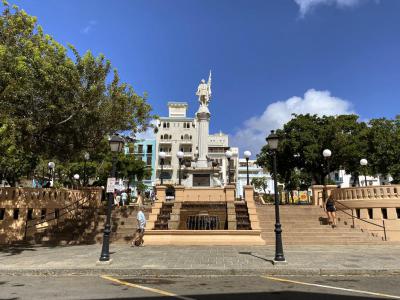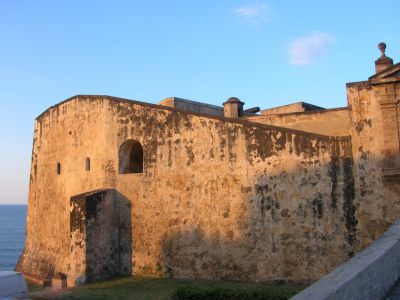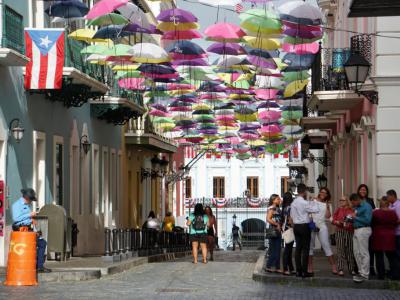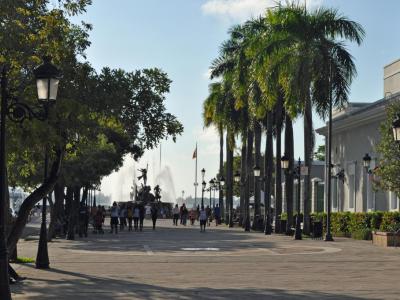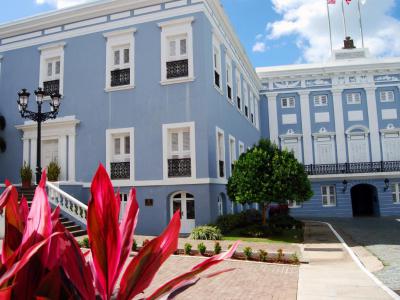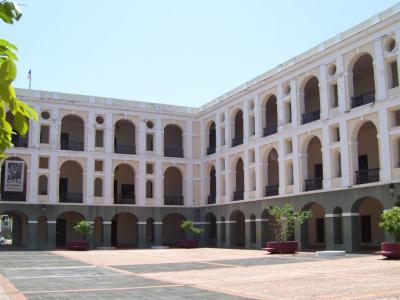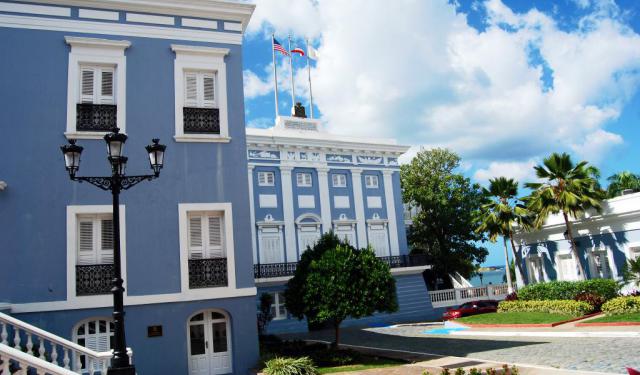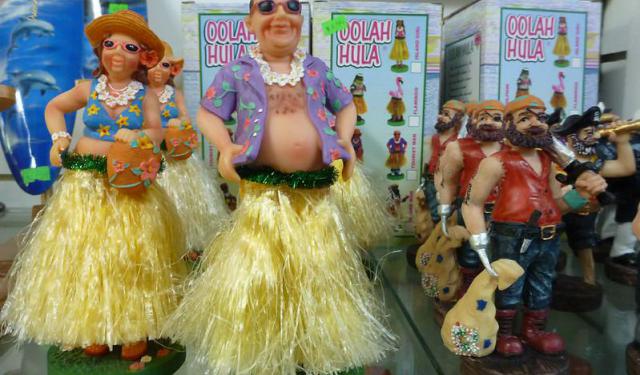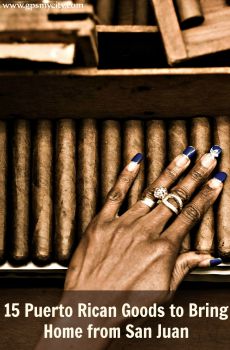Audio Guide: Old San Juan Walking Tour (Self Guided), San Juan
Founded by Spanish colonists in 1509, at a site then known as "Puerto Rico" (which means Rich Port in Spanish), San Juan is the third oldest capital in the Americas established by Europeans. In 1521, the words "San Juan" were added to its official name, thus making it "San Juan Bautista de Puerto Rico". This was in keeping with the custom of christening the town with both its formal name and that which Christopher Columbus had originally given to the islands, honoring John the Baptist.
During colonial times, most of the city population resided in what is now known as Old (Viejo) San Juan. In 1983, this lovely part of town, characterized by narrow, blue cobblestone streets, and picturesque, brightly colored buildings (some of which date back almost 500 years), was declared by UNESCO a World Heritage Site.
One of its architectural jewels, La Fortaleza, also known as the Santa Catalina Palace, is the oldest executive mansion still in use on the American continent; it was built between 1533 and 1540. Another historical site, the El Morro castle, dates back to 1584. In 1771, the city housed the largest Spanish fortification in the Americas, the San Cristóbal fortress.
Before the 19th century, the area outside the city walls, occupying the east side of Old San Juan Island, was almost uninhabited. In 1865, to facilitate further expansion of the city, the walls along the eastern side of the island were demolished.
In the 1890s, the United States sought to expand its influence over the Caribbean with the help of its navy. This involved the acquisition of colonies that would serve as strategic points of defense and allow easier passage of ships between the Atlantic and Pacific oceans.
Pursuant to this objective, the United States offered to purchase Puerto Rico and Cuba from Spain for 160 million dollars. After the proposal was rejected, the U.S. invaded Puerto Rico, on 25 July 1898, as part of the Spanish–American War. After the Americans prevailed in the conflict, the Spanish ceded Puerto Rico, in 1899, thus marking the outset of the long-standing relationship between the U.S. and Puerto Rico.
By the late 1940s, the Old Town of San Juan had fallen into disrepair. To preserve its historic fortifications, the National Historic Site was established, in 1949. Among the key local landmarks are Plaza Colon (Columbus Square), Paseo de la Princesa (Promenade of the Princess), the San Juan Gate and City Walls, Plaza de Armas (Arms Square), and, of course, the historic San Juan City Hall, the Cathedral of San Juan Bautista, and others.
To explore Old San Juan in more detail and soak in its historical atmosphere, take this self-guided walking tour. You may feel yourself traveling back in time, if only for an hour or so.
During colonial times, most of the city population resided in what is now known as Old (Viejo) San Juan. In 1983, this lovely part of town, characterized by narrow, blue cobblestone streets, and picturesque, brightly colored buildings (some of which date back almost 500 years), was declared by UNESCO a World Heritage Site.
One of its architectural jewels, La Fortaleza, also known as the Santa Catalina Palace, is the oldest executive mansion still in use on the American continent; it was built between 1533 and 1540. Another historical site, the El Morro castle, dates back to 1584. In 1771, the city housed the largest Spanish fortification in the Americas, the San Cristóbal fortress.
Before the 19th century, the area outside the city walls, occupying the east side of Old San Juan Island, was almost uninhabited. In 1865, to facilitate further expansion of the city, the walls along the eastern side of the island were demolished.
In the 1890s, the United States sought to expand its influence over the Caribbean with the help of its navy. This involved the acquisition of colonies that would serve as strategic points of defense and allow easier passage of ships between the Atlantic and Pacific oceans.
Pursuant to this objective, the United States offered to purchase Puerto Rico and Cuba from Spain for 160 million dollars. After the proposal was rejected, the U.S. invaded Puerto Rico, on 25 July 1898, as part of the Spanish–American War. After the Americans prevailed in the conflict, the Spanish ceded Puerto Rico, in 1899, thus marking the outset of the long-standing relationship between the U.S. and Puerto Rico.
By the late 1940s, the Old Town of San Juan had fallen into disrepair. To preserve its historic fortifications, the National Historic Site was established, in 1949. Among the key local landmarks are Plaza Colon (Columbus Square), Paseo de la Princesa (Promenade of the Princess), the San Juan Gate and City Walls, Plaza de Armas (Arms Square), and, of course, the historic San Juan City Hall, the Cathedral of San Juan Bautista, and others.
To explore Old San Juan in more detail and soak in its historical atmosphere, take this self-guided walking tour. You may feel yourself traveling back in time, if only for an hour or so.
How it works: Download the app "GPSmyCity: Walks in 1K+ Cities" from Apple App Store or Google Play Store to your mobile phone or tablet. The app turns your mobile device into a personal tour guide and its built-in GPS navigation functions guide you from one tour stop to next. The app works offline, so no data plan is needed when traveling abroad.
Old San Juan Walking Tour Map
Guide Name: Old San Juan Walking Tour
Guide Location: Puerto Rico » San Juan (See other walking tours in San Juan)
Guide Type: Self-guided Walking Tour (Sightseeing)
# of Attractions: 10
Tour Duration: 2 Hour(s)
Travel Distance: 3.1 Km or 1.9 Miles
Author: leticia
Sight(s) Featured in This Guide:
Guide Location: Puerto Rico » San Juan (See other walking tours in San Juan)
Guide Type: Self-guided Walking Tour (Sightseeing)
# of Attractions: 10
Tour Duration: 2 Hour(s)
Travel Distance: 3.1 Km or 1.9 Miles
Author: leticia
Sight(s) Featured in This Guide:
- Plaza Colon (Columbus Square)
- Castillo San Cristóbal (Fort San Cristobal)
- Calle de la Fortaleza (Fortaleza Street)
- Paseo de la Princesa (Princess Promenade)
- San Juan Gate and City Wall
- La Fortaleza (The Fortress)
- Plaza de Armas (Arms Square)
- Cathedral of San Juan Bautista
- Museum of the Americas
- El Castillo San Felipe del Morro (Fort El Morro)
1) Plaza Colon (Columbus Square)
Columbus Square, originally known as Santiago Square, is one of the most important squares in San Juan, symbolizing progress and, at the same time, a testament to the old times. In the 17th century, the area marked the doorstep to the city, which was encircled by stone walls, from 1635-1641. The only way into the capital, back then, was through the five gates, the centermost of which was the Puerta de Santiago (or Land Gate), straddling the only highway linking the walled San Juan islet to the rest of Puerto Rico by land.
By 1772, the open space adjacent to Puerta de Santiago, while still unpaved, had taken the shape of Santiago Square. From 1862 to 1870, it was refurbished and the square finally started to take its current form. In 1893, the statue of Christopher Columbus was installed to commemorate the 400th anniversary of the discovery of Puerto Rico, following which the square itself was renamed Colón or Columbus Square.
To the south of it, today is the Tapia Theater, a true gem of Puerto Rican entertainment culture. Inaugurated in 1824, this lovely neoclassical structure was initially known as the San Juan Municipal Theater. Throughout the years, many notable performers have graced its stage. Outside the theater, along Fortaleza Street, there are a number of quaint restaurants and cute little cafes where one can sip some iced coffee outside whilst enjoying the sight of Columbus Square.
By 1772, the open space adjacent to Puerta de Santiago, while still unpaved, had taken the shape of Santiago Square. From 1862 to 1870, it was refurbished and the square finally started to take its current form. In 1893, the statue of Christopher Columbus was installed to commemorate the 400th anniversary of the discovery of Puerto Rico, following which the square itself was renamed Colón or Columbus Square.
To the south of it, today is the Tapia Theater, a true gem of Puerto Rican entertainment culture. Inaugurated in 1824, this lovely neoclassical structure was initially known as the San Juan Municipal Theater. Throughout the years, many notable performers have graced its stage. Outside the theater, along Fortaleza Street, there are a number of quaint restaurants and cute little cafes where one can sip some iced coffee outside whilst enjoying the sight of Columbus Square.
2) Castillo San Cristóbal (Fort San Cristobal) (must see)
Standing guard at the eastern gate, north of Columbus Square, is an imposing 18th-century fortress, called San Cristóbal. Contrary to her sister, El Morro, which was designed to protect from attacks by sea, the San Cristóbal Fort guarded the city against the enemy approaching by land, for which purpose it created a crossfire with El Morro over the bay. The citadel construction began in 1634 and was meant to strengthen the Spanish position in the face of imminent English and Dutch invasion.
The fort was named San Cristóbal in celebration of the Spanish victories which enabled ejecting of the English and Dutch interlopers from the island of the same name in the Lesser Antilles, which was then part of the insular territorial glacis of Puerto Rico.
When finished in 1783, the Fort San Cristóbal covered nearly 27 acres of land and practically wrapped around the whole of San Juan, with the entry to the city sealed by the San Cristóbal's double gates. After almost 100 years of relative peace, about a third of the fortification was demolished, in 1897, to help ease the flow of traffic in and out of the walled city.
The Fort San Cristóbal is now a listed National Historic Site. It is particularly worth visiting as the largest fortification ever built by the Spanish in the New World, where the first shots of the Spanish-American War were fired. If you're a keen photographer, San Cristobal is a goldmine of panoramic views of the coast, from Old San Juan to Condado and beyond.
Tip:
Guided tours by local rangers visit the extensive tunnel system connecting various sections of the fort. There is an exhibition of military clothing. Be sure to visit the overlook for the Devil's Sentry Box ("Garita del Diablo"), from which, according to legends, soldiers mysteriously disappeared. Tickets to San Cristobal or El Morro can be used to enter either of the forts.
The fort was named San Cristóbal in celebration of the Spanish victories which enabled ejecting of the English and Dutch interlopers from the island of the same name in the Lesser Antilles, which was then part of the insular territorial glacis of Puerto Rico.
When finished in 1783, the Fort San Cristóbal covered nearly 27 acres of land and practically wrapped around the whole of San Juan, with the entry to the city sealed by the San Cristóbal's double gates. After almost 100 years of relative peace, about a third of the fortification was demolished, in 1897, to help ease the flow of traffic in and out of the walled city.
The Fort San Cristóbal is now a listed National Historic Site. It is particularly worth visiting as the largest fortification ever built by the Spanish in the New World, where the first shots of the Spanish-American War were fired. If you're a keen photographer, San Cristobal is a goldmine of panoramic views of the coast, from Old San Juan to Condado and beyond.
Tip:
Guided tours by local rangers visit the extensive tunnel system connecting various sections of the fort. There is an exhibition of military clothing. Be sure to visit the overlook for the Devil's Sentry Box ("Garita del Diablo"), from which, according to legends, soldiers mysteriously disappeared. Tickets to San Cristobal or El Morro can be used to enter either of the forts.
Sight description based on Wikipedia.
3) Calle de la Fortaleza (Fortaleza Street) (must see)
Proudly presiding over the bay of San Juan is the imposing La Fortaleza (Fortress), formally known as the Palace of Santa Catalina, the official residence of the Governor of Puerto Rico. The narrow road leading to the building, called Fortaleza Street, is the main artery of San Juan's historic quarter, cutting through most of it, and is also the oldest street in the area. It starts from Columbus Square and for the whole of its duration is lined with governmental buildings, hotels, perfumeries, craft shops, jewelry stores, and restaurants, gradually transforming into Avenue Juan Ponce de León in the east.
Just like many other colorful cobblestone streets in Old San Juan, each one more photogenic than the other, this thoroughfare is an important tourist attraction, in large part due to its historical and cultural significance. Visiting Fortaleza Street should be an integral part of every Old San Juan itinerary.
While the walled-in Old City has no shortage of vibrant photo spots, Fortaleza Street stands out above the rest due to the display of umbrellas – at the end of the street, near La Fortaleza itself – creating an overhead canopy that makes it particularly recognizable. These umbrellas tend to change colors during the year, from rainbow to all pink. Before the umbrellas, La Fortaleza Street was adorned with colorful kites.
Just like many other colorful cobblestone streets in Old San Juan, each one more photogenic than the other, this thoroughfare is an important tourist attraction, in large part due to its historical and cultural significance. Visiting Fortaleza Street should be an integral part of every Old San Juan itinerary.
While the walled-in Old City has no shortage of vibrant photo spots, Fortaleza Street stands out above the rest due to the display of umbrellas – at the end of the street, near La Fortaleza itself – creating an overhead canopy that makes it particularly recognizable. These umbrellas tend to change colors during the year, from rainbow to all pink. Before the umbrellas, La Fortaleza Street was adorned with colorful kites.
Sight description based on Wikipedia.
4) Paseo de la Princesa (Princess Promenade) (must see)
No trip to San Juan is complete without a stroll along the beautiful Princess Promenade, a carefully restored historic landmark, one of the most visited in the capital. Built in 1853, this esplanade skirts the curved city walls on the southern side of Old San Juan and is quite picture-perfect, with the San Juan Bay on the one side and the impressive fortification walls on the other.
The Promenade is equally suited for both walking and people-watching. It is also a great place to visit for families with children – easily accessible and traffic-free. The abundance of trees here provides plenty of shade, and there are lots of artisan stalls and street vendors selling local food. The area also often hosts festivals and fairs on weekends.
From here, you can make a slight detour to the narrow path, known as Paseo El Morro, leading to the historic El Morro Fort and the nearby San Juan Gate, which is the only city gate remaining from the colonial period.
Princess Promenade gets its name from an old 1837 building, located here, known as La Princesa. Originally, this building served as a municipal prison, although presently it houses the headquarters of the Puerto Rico Tourism Company and an art gallery.
The Promenade is equally suited for both walking and people-watching. It is also a great place to visit for families with children – easily accessible and traffic-free. The abundance of trees here provides plenty of shade, and there are lots of artisan stalls and street vendors selling local food. The area also often hosts festivals and fairs on weekends.
From here, you can make a slight detour to the narrow path, known as Paseo El Morro, leading to the historic El Morro Fort and the nearby San Juan Gate, which is the only city gate remaining from the colonial period.
Princess Promenade gets its name from an old 1837 building, located here, known as La Princesa. Originally, this building served as a municipal prison, although presently it houses the headquarters of the Puerto Rico Tourism Company and an art gallery.
5) San Juan Gate and City Wall (must see)
Built in the late 1700s, the San Juan Gate is a giant (40 feet high) structure, the last remaining of the original five gates carved into the three-mile wall that once surrounded the city. Today, the wall wraps around Old San Juan, from the cruise ship piers on San Juan Harbor to the capitol on the Atlantic.
Originally, each gate had a designated function. The red gate of San Juan played a symbolic role, serving as the main entrance to the city, and was named in honor of Saint John the Baptist. The first thing you notice approaching it is the inscription of The Sanctus ("Holy") hymn from the Catholic liturgy.
The city wall is the most enduring symbol of Puerto Rico and was built by the Spanish between 1539 and 1782. Made of sandstone, rubble, and mortar blocks – 20 feet thick, the wall measures 45 feet wide and 40 feet high in some parts and was meant to protect San Juan from invaders, notably the English, the Dutch, and the Americans. Its iconic sentry boxes now symbolize the island's Spanish heritage and resilience in an ever-changing world.
Nearly impenetrable to foreign attack, the city wall proved defenseless, nonetheless, against modern automobile traffic, pollution, and misguided attempts to preserve it that have seriously endangered the wall, leaving it crumbling in some places.
Currently a National Historic Site, the city wall is maintained by the National Park Service which attempts to recreate the magic mixture of sand, water, and limestone that was once used to stucco the wall. Along with the adjoining fortresses of El Morro and San Cristóbal, the city wall attracts 1.2 million visitors each year.
Tip:
As you walk through the gate, just pause for a second and notice how thick the walls really are. Also, check out the street vendors outside, on the corner, offering refreshments including Puerto Ricans' favorite, piragua.
Originally, each gate had a designated function. The red gate of San Juan played a symbolic role, serving as the main entrance to the city, and was named in honor of Saint John the Baptist. The first thing you notice approaching it is the inscription of The Sanctus ("Holy") hymn from the Catholic liturgy.
The city wall is the most enduring symbol of Puerto Rico and was built by the Spanish between 1539 and 1782. Made of sandstone, rubble, and mortar blocks – 20 feet thick, the wall measures 45 feet wide and 40 feet high in some parts and was meant to protect San Juan from invaders, notably the English, the Dutch, and the Americans. Its iconic sentry boxes now symbolize the island's Spanish heritage and resilience in an ever-changing world.
Nearly impenetrable to foreign attack, the city wall proved defenseless, nonetheless, against modern automobile traffic, pollution, and misguided attempts to preserve it that have seriously endangered the wall, leaving it crumbling in some places.
Currently a National Historic Site, the city wall is maintained by the National Park Service which attempts to recreate the magic mixture of sand, water, and limestone that was once used to stucco the wall. Along with the adjoining fortresses of El Morro and San Cristóbal, the city wall attracts 1.2 million visitors each year.
Tip:
As you walk through the gate, just pause for a second and notice how thick the walls really are. Also, check out the street vendors outside, on the corner, offering refreshments including Puerto Ricans' favorite, piragua.
6) La Fortaleza (The Fortress) (must see)
La Fortaleza, or the Fortress, is the current official residence of the Governor of Puerto Rico. Built between 1533 and 1540 to defend the harbor of San Juan, it is the oldest executive mansion in the New World. During the 1640 reconstruction, the chapel of Santa Catalina, then located outside the city walls, was demolished and integrated into the complex, which, upon that, assumed the new (current) name, Palacio de Santa Catalina.
La Fortaleza was the first defensive fortification built in San Juan, and the first of the series of military installations designed to protect the city, among which were the Fort San Felipe del Morro and Fort San Cristóbal. The construction was authorized by Charles V, the Holy Roman Emperor, as a defensive measure against the attacks from Carib Indians and the rivaling European powers.
The fortress underwent massive reconstruction in 1846 to convert from military use to a palatial residence. Since then, La Fortaleza has been the home to more than 170 governors of Puerto Rico and hosted various dignitaries, including President John F. Kennedy and his wife, Jacqueline Kennedy, who stayed here in 1961. At present, the complex consists of a few attached buildings with formal living quarters on the second floor, and private quarters on the third. The palace overlooks the high city walls fronting the bay, and its northern part contains sheltered gardens and a swimming pool.
The complex has been a UNESCO World Heritage Site since 1983 and as such may present definite interest to both history and architecture buffs with a taste for Spanish designs.
La Fortaleza was the first defensive fortification built in San Juan, and the first of the series of military installations designed to protect the city, among which were the Fort San Felipe del Morro and Fort San Cristóbal. The construction was authorized by Charles V, the Holy Roman Emperor, as a defensive measure against the attacks from Carib Indians and the rivaling European powers.
The fortress underwent massive reconstruction in 1846 to convert from military use to a palatial residence. Since then, La Fortaleza has been the home to more than 170 governors of Puerto Rico and hosted various dignitaries, including President John F. Kennedy and his wife, Jacqueline Kennedy, who stayed here in 1961. At present, the complex consists of a few attached buildings with formal living quarters on the second floor, and private quarters on the third. The palace overlooks the high city walls fronting the bay, and its northern part contains sheltered gardens and a swimming pool.
The complex has been a UNESCO World Heritage Site since 1983 and as such may present definite interest to both history and architecture buffs with a taste for Spanish designs.
Sight description based on Wikipedia.
7) Plaza de Armas (Arms Square) (must see)
Arms Square is the de-facto central square of San Juan. Over the years, it has changed several names relative to the functions it served. Initially, in 1521, it was called Vegetables Square. Then, during the 17th-19th centuries, it was known as Arms Square, for being the grounds for military drills. After that, in the early 20th century, it turned back to being called Vegetables Square once again, serving as a marketplace, before it finally re-assumed the Arms Square title.
The plaza is modeled on the classic squares of Madrid and Mexico City. Although it factually existed for centuries, it was not until 1840 that the city council approved its proper development, which started in 1851. It was at that time that the four bronze statues, oil-coated to simulate marble, representing Commerce, Industry, Science, and the Arts, arrived here (there were a total of eight statues to be installed, but the other four were lost). In 1872, the original statues were replaced with the new marble ones, representing the Four Seasons, put in the four corners of the square.
In 1955, two circular fountains and two lampposts in the center were added. The four statues were then configured in a circular fountain outside the Palacio de la Real Intendencia, which is the seat of the Department of State of Puerto Rico, on the western side of the square.
A highlight of the northern side is the Casa Alcaldía – home of the San Juan City Hall. Built in 1789, this Spanish colonial-style edifice with twin turrets resembles its sister building in Madrid. The tinkling of the fountain, the comfortable seating in the shade of the trees, and the presence of several old-style coffee booths selling snacks have long attracted tourists as a good spot for a sightseeing break when you can stretch out your feet and soak up some of the everyday comings and goings.
The laid-back atmosphere of the place also made it a popular gathering venue with locals, offering a chance to buy kids some traditional treats (like sesame-seed lollipops or coconut candies), watch shows, play dominoes, or chit-chat with friends.
The plaza is modeled on the classic squares of Madrid and Mexico City. Although it factually existed for centuries, it was not until 1840 that the city council approved its proper development, which started in 1851. It was at that time that the four bronze statues, oil-coated to simulate marble, representing Commerce, Industry, Science, and the Arts, arrived here (there were a total of eight statues to be installed, but the other four were lost). In 1872, the original statues were replaced with the new marble ones, representing the Four Seasons, put in the four corners of the square.
In 1955, two circular fountains and two lampposts in the center were added. The four statues were then configured in a circular fountain outside the Palacio de la Real Intendencia, which is the seat of the Department of State of Puerto Rico, on the western side of the square.
A highlight of the northern side is the Casa Alcaldía – home of the San Juan City Hall. Built in 1789, this Spanish colonial-style edifice with twin turrets resembles its sister building in Madrid. The tinkling of the fountain, the comfortable seating in the shade of the trees, and the presence of several old-style coffee booths selling snacks have long attracted tourists as a good spot for a sightseeing break when you can stretch out your feet and soak up some of the everyday comings and goings.
The laid-back atmosphere of the place also made it a popular gathering venue with locals, offering a chance to buy kids some traditional treats (like sesame-seed lollipops or coconut candies), watch shows, play dominoes, or chit-chat with friends.
8) Cathedral of San Juan Bautista (must see)
The Cathedral of San Juan Bautista is the Roman Catholic temple and the seat of the Archdiocese of San Juan de Puerto Rico. This is one of the oldest buildings in San Juan and the second-oldest operational church in the Americas. Traditionally, travelers entering San Juan Gate would make this cathedral their first stop in the city to thank God for their safe journey.
It sits on the site of a grammar school, established in 1513 by Bishop Alonso Manso. This was the first school in Puerto Rico (and the oldest school in the United States after Puerto Rico became a US territory). Here, the Latin language, literature, history, science, art, philosophy, and theology were taught free of charge.
The very first, wooden, church on this spot was built in 1521. It was destroyed by a hurricane, and the current temple of stone was built in its place, in 1540. The church was remodeled several times over the course of centuries, most recently in 1917.
The cathedral contains the tomb of the Spanish explorer Juan Ponce de León. It also houses a shrine dedicated to the Blessed Carlos Manuel Rodríguez Santiago, the first Puerto Rican and the first Caribbean-born layperson (much as the first layperson in the history of the United States) to be beatified.
The Cathedral of San Juan Bautista is also unique as a rare example of medieval Spanish architecture in the New World.
It sits on the site of a grammar school, established in 1513 by Bishop Alonso Manso. This was the first school in Puerto Rico (and the oldest school in the United States after Puerto Rico became a US territory). Here, the Latin language, literature, history, science, art, philosophy, and theology were taught free of charge.
The very first, wooden, church on this spot was built in 1521. It was destroyed by a hurricane, and the current temple of stone was built in its place, in 1540. The church was remodeled several times over the course of centuries, most recently in 1917.
The cathedral contains the tomb of the Spanish explorer Juan Ponce de León. It also houses a shrine dedicated to the Blessed Carlos Manuel Rodríguez Santiago, the first Puerto Rican and the first Caribbean-born layperson (much as the first layperson in the history of the United States) to be beatified.
The Cathedral of San Juan Bautista is also unique as a rare example of medieval Spanish architecture in the New World.
Sight description based on Wikipedia.
9) Museum of the Americas (must see)
Located in the old Spanish Military Barracks, the Museum of the Americas is a multidisciplinary, multicultural, and multidimensional non-profit institution, established in 1992 by San Juan's famed archaeologist Ricardo Alegria. Its mission is to offer a synoptic vision of the history and culture of the American continent, with the main emphasis on Puerto Rico, through exhibition programs and cultural activities.
Dedicated to the American culture, the museum displays four permanent exhibits, namely: the Natives in the Americas; the African Legacy; Conquest and Colonization; and the Popular Arts. Additionally, there are some changing exhibitions as well, featuring paintings, carved and other sculptures, as well as many other works by artisans representing North, South, and Central America.
A true gem of curatorial design, to date the museum has hosted over 500 temporary exhibitions of art, history, and anthropology.
Tip:
The main language of the displays is Spanish, whereas some areas offer readable English translations. If you do not read Spanish, consider using the provided recorded audio tours.
It may take up to one and a half to two hours to explore all eight galleries. The museum closes at lunchtime, so plan accordingly.
Dedicated to the American culture, the museum displays four permanent exhibits, namely: the Natives in the Americas; the African Legacy; Conquest and Colonization; and the Popular Arts. Additionally, there are some changing exhibitions as well, featuring paintings, carved and other sculptures, as well as many other works by artisans representing North, South, and Central America.
A true gem of curatorial design, to date the museum has hosted over 500 temporary exhibitions of art, history, and anthropology.
Tip:
The main language of the displays is Spanish, whereas some areas offer readable English translations. If you do not read Spanish, consider using the provided recorded audio tours.
It may take up to one and a half to two hours to explore all eight galleries. The museum closes at lunchtime, so plan accordingly.
10) El Castillo San Felipe del Morro (Fort El Morro) (must see)
The Fort San Felipe del Morro, or simply El Morro, is a 16th-century citadel on the northwestern tip of the San Juan islet, named in honor of King Philip II of Spain. It was the second military installation, after La Fortaleza, built in what is now known as the Old Town.
The construction began in 1539, authorized by King Charles V, and was finished in 1790. During that period, El Morro had been transformed from a promontory mounted with a cannon to a six-level fortress designed to guard the entrance to the bay of San Juan from seaborne invaders. Many more structures were added to the complex over the next 400 years; the outer walls, built initially 6 feet (1.8 m) thick, were augmented to 18 feet (5.5 m) by the end of the 18th century.
Thanks to El Morro, the Spanish were able to defend Puerto Rico from invasions by the British and the Dutch, as well as pirates. In 1898, following the Spanish-American War, the island changed hands from Spain to the United States. El Morro was actively used as a military installation during the First and Second World Wars.
In 1961, the US Army retired El Morro, passing it on to the National Park Service to use it as a museum. In 1983, El Morro and the walled city of Old San Juan were declared UNESCO World Heritage Sites.
Tips:
A ticket to El Morro allows entry to the Castillo San Cristóbal (and vice versa) for a single fee.
The construction began in 1539, authorized by King Charles V, and was finished in 1790. During that period, El Morro had been transformed from a promontory mounted with a cannon to a six-level fortress designed to guard the entrance to the bay of San Juan from seaborne invaders. Many more structures were added to the complex over the next 400 years; the outer walls, built initially 6 feet (1.8 m) thick, were augmented to 18 feet (5.5 m) by the end of the 18th century.
Thanks to El Morro, the Spanish were able to defend Puerto Rico from invasions by the British and the Dutch, as well as pirates. In 1898, following the Spanish-American War, the island changed hands from Spain to the United States. El Morro was actively used as a military installation during the First and Second World Wars.
In 1961, the US Army retired El Morro, passing it on to the National Park Service to use it as a museum. In 1983, El Morro and the walled city of Old San Juan were declared UNESCO World Heritage Sites.
Tips:
A ticket to El Morro allows entry to the Castillo San Cristóbal (and vice versa) for a single fee.
Sight description based on Wikipedia.
Walking Tours in San Juan, Puerto Rico
Create Your Own Walk in San Juan
Creating your own self-guided walk in San Juan is easy and fun. Choose the city attractions that you want to see and a walk route map will be created just for you. You can even set your hotel as the start point of the walk.
San Juan Historical Buildings
One of the oldest capital cities on the American continent, San Juan, Puerto Rico, boasts an old town that is filled to the brim with heritage colonial architecture.
Chief among its historical buildings, La Fortaleza, or The Fortress, is the official residence of the Governor of Puerto Rico and the longest-standing executive mansion in continuous use in America. At the same time, the Cathedral... view more
Tour Duration: 2 Hour(s)
Travel Distance: 2.4 Km or 1.5 Miles
Chief among its historical buildings, La Fortaleza, or The Fortress, is the official residence of the Governor of Puerto Rico and the longest-standing executive mansion in continuous use in America. At the same time, the Cathedral... view more
Tour Duration: 2 Hour(s)
Travel Distance: 2.4 Km or 1.5 Miles
Souvenir Shopping
The arrival of Christopher Columbus in 1493 and the ensuing Spanish colonization brought into Puerto Rico a number of new crafts. Over the next few centuries, having mixed up with local traditions, they have flourished on the new turf, producing an array of colorful products that today are sought after by tourists visiting the island. While in San Juan, it would be a pity to leave town without... view more
Tour Duration: 1 Hour(s)
Travel Distance: 0.6 Km or 0.4 Miles
Tour Duration: 1 Hour(s)
Travel Distance: 0.6 Km or 0.4 Miles
Old San Juan Squares
A distinctive feature of Old San Juan is the multitude of quaint picturesque squares, many of them adorned with beautiful fountains and spectacular monuments. Each square has a unique character and historical significance, making them integral to the city's identity.
Plaza Colon, also known as Columbus Square, pays homage to Christopher Columbus and his exploration of the New World. It... view more
Tour Duration: 1 Hour(s)
Travel Distance: 1.8 Km or 1.1 Miles
Plaza Colon, also known as Columbus Square, pays homage to Christopher Columbus and his exploration of the New World. It... view more
Tour Duration: 1 Hour(s)
Travel Distance: 1.8 Km or 1.1 Miles
Useful Travel Guides for Planning Your Trip
12 Distinctively Puerto Rican Goods to Bring Home from San Juan
The uniqueness of Puerto Rico is partially associated with its political status - part of the United States yet with a Latin twist. Other than their widely-acknowledged musical talents, e.g. Carlos Santana and Ricky Martin, Puerto Rico is just as rich in many other good things. When you're in...
The Most Popular Cities
/ view all



